I first tasted absinthe in 2003.
I’d heard about it well before then, but stumbled upon an article about it. The article made it sound like it was a drug — a stigma the drink carries to this day.
“You’ll Trip Balls, Right?”
Here’s the thing: absinthe doesn’t make you hallucinate. The thujone in grand wormwood contains no trippy properties. I won’t go into great detail, here, but absinthe suffered from two issues back in the day: shoddy production by some producers and a smear campaign by the wine industry. (Absinthe was (and sometimes still is) distilled with a grape-based spirit. During a grape shortage, the wine industry suffered and set out to make absinthe sound like the drink of mad men…leading to a ban on the drink in the early 1900s. It didn’t hurt that substances used to dye cheap absinthe often contained harmful compounds that really did drive some people mad…in the same way that eating lead paint chips wasn’t a good idea.)
But enough history…
In the past 15 years or so, absinthe has made a comeback. It’s now legal in the United States. You can buy it in most liquor stores (varying qualities). If you want a good absinthe, I recommend anything made by Ted Breaux for his Jade line.
The neat thing about Breaux’s absinthes? He’s a chemist and distiller, and he created his line by working backwards from samples of vintage absinthes. I can now say with confidence that he got it right!
Pernod Fils (Circa 1890-1900)
For years, I’ve been on a mailing list for someone who finds vintage spirits…with a heavy focus on absinthe. And for years, I could never justify the price of samples sold when a few bottles are discovered from the pre-ban years before absinthe was outlawed in various countries between 1910-1914.
Recently, I set aside some money and told myself, “If a pre-ban bottle of Pernod Fils is found this spring, I’m jumping on it!” And ‘lo, a pre-ban bottle was discovered and broken into samples. (The bottle above.)
Isn’t It Supposed To Be Green?
If you watched Moulin Rouge, you might think that absinthe is a neon green drink that summons fairies. (I do love that movie, even though the absinthe depiction is quite off.)
Most modern, traditionally made absinthes are green in the same way olive oil is green. It’s not a bright green, but it’s definitely green. (Although some absinthes are more of a straw color, while others are absolutely clear.) So why isn’t the sample below green?
Over time, the chlorophyll that gives absinthe its green hue degrades, taking on the color of a dead leaf. (Fuille morte.) Sometimes the flavor changes, becoming more earthy; other times, the taste does what many other spirits and wines do with time: they blend and end up more full and rounded.
We took a sip of the straight sample, and right away — it tasted like some absinthes that have already been diluted with water and sugar. It was sweet and full and creamy. (Damn, it was good!)
Of course, we had to go the traditional route.
How Do You Serve Absinthe?
If you see someone set a sugar cube above a glass of absinthe on fire, don’t drink it. It’s probably a crappy absinthe served in a party atmosphere. I really don’t care how others drink something they pay for (I know someone who drowns Islay malt scotches in ice; makes me cringe, but he’s free to do with what he buys), but I’ve heard a lot of people say, “I HATE absinthe! “… only to find they drank swill that wasn’t even absinthe.
Traditionally, absinthe is served by dripping or slowly pouring very cold water into the drink. Depending on the absinthe and one’s taste, the drip is often over a sugar cube on a slotted spoon resting on the glass. (The sugar dissolves, taking an edge off the bitterness of wormwood the drink can have.)
For this drink, we used no sugar. Only ice water from the fountain we’ve had for almost 15 years.
The Louche
With the introduction of water, absinthe gets hazy, until turning opaque. This effect is called a louche. (Ouzo and some other spirits containing anise and fennel also louche.)
With the louche, the aromas open up, leaving the room smelling so fragrant.
What Does It Taste Like?
A lot of people say, “Absinthe tastes like black licorice!”
I’ve never seen it that strong. It’s more like fennel: a subdued licorice flavor, mixed with a taste of hay dust on the roof on your mouth. It tastes like fields and hills and summer distilled to its essence. It’s a very refreshing drink that some people I know who hate black licorice find pleasant. It’s big and herbal and wonderful!
(I was the kid who always took everybody’s black licorice, so I probably like it even more. I wrote a little bit about the flavor here.)
What Did This Glass Taste Like?
In a blind taste test, I’m guessing most people who have consumed good absinthe would say it tastes a lot like the absinthes Ted Breaux makes. Not quite as earthy — the floral qualities winning out over the taste of distant hay fields and wormwood. It was creamier — and the flavor lingered much longer than any other absinthe I’ve tasted.
The neat taste was sublime; truly one of the best taste experiences of my life. I wanted to drink it straight — and with its high alcohol content, it didn’t have a huge attack in that sip. The astringent qualities seemed subdued and stronger at the same time
. Once water was added, it was much like some of the better modern absinthes.
But I didn’t buy enough for two glasses for just the taste…
A Taste of History
As I drank the glass, I thought about the region where it was distilled. I wondered whose hands grew and harvested the herbs used in the drink — and who was responsible for distilling the bottle. (The bottle this sample was drawn from.) I wondered where other bottles from that distilling run went: who drank them — and are there any others still out there in a cellar somewhere?
Even had this drink not lived up to my taste expectations, it would have been worth it, just to imbibe something that was distilled somewhere between 1890 and 1900. Splitting the dates, today I drank 120-year-old absinthe, and it was worth every friggin’ cent I paid for it!
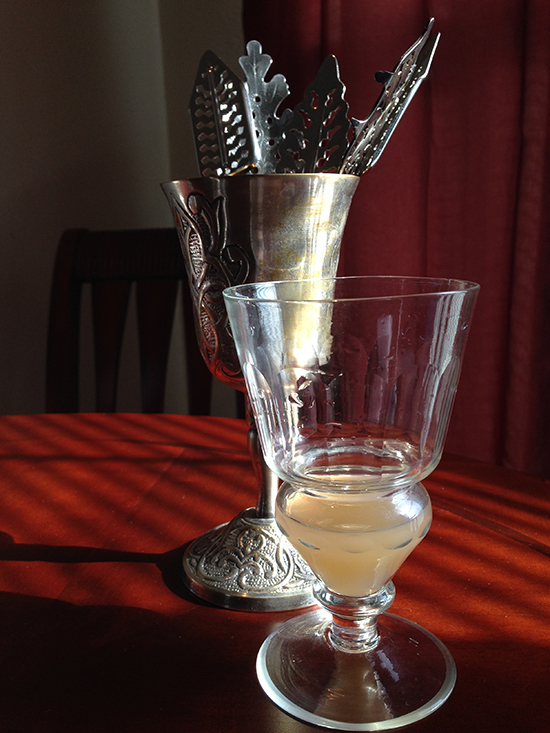
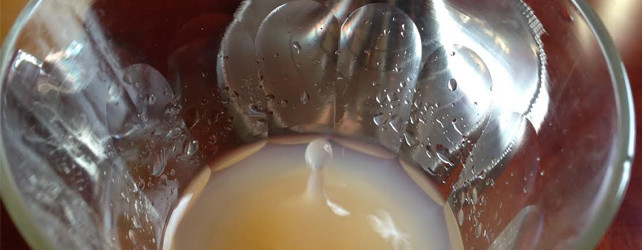
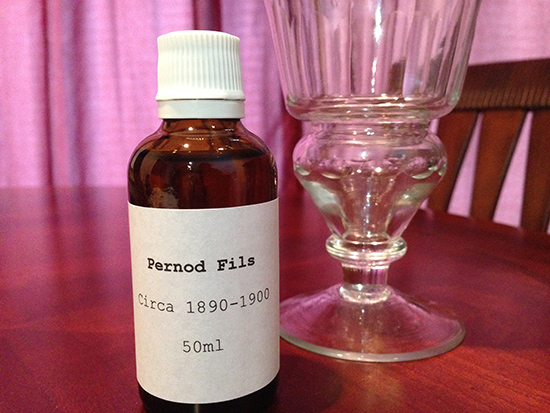
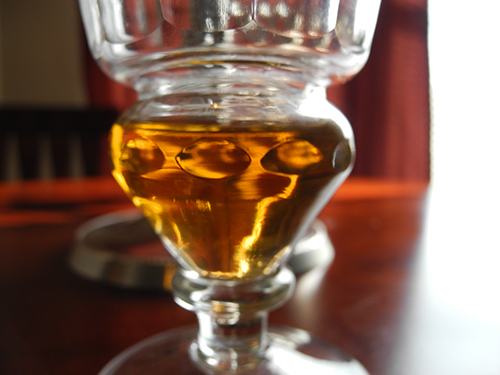
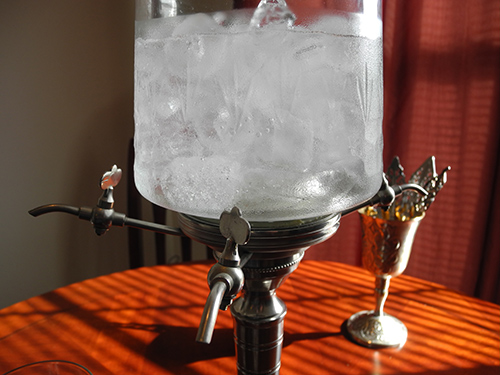
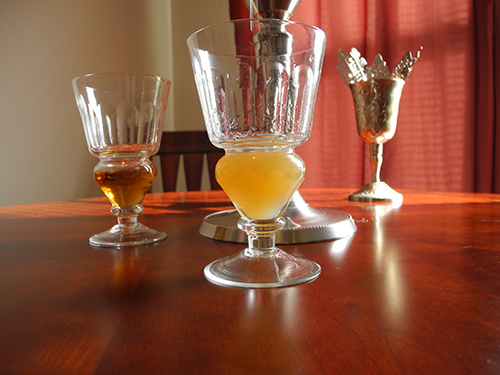
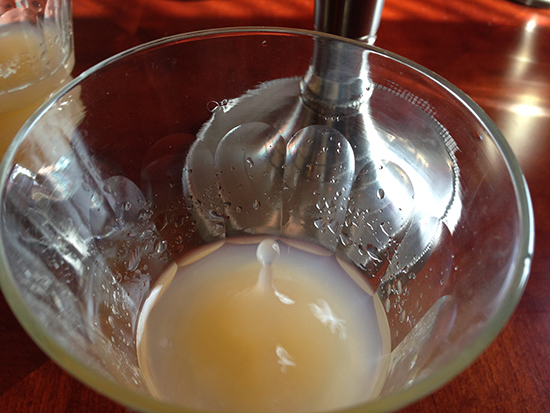

Wonderfully written! I’m so glad we finally had a chance to do this. It was a little weird and scary jumping on something like this (it’s a bit expensive for the small amount you get, so it works better for one person or a couple who share a love of not just a drink but the reality and history as well as the ceremony of preparing it), but as much as we love and appreciate history that’s as close as we can get to time travel. 😉